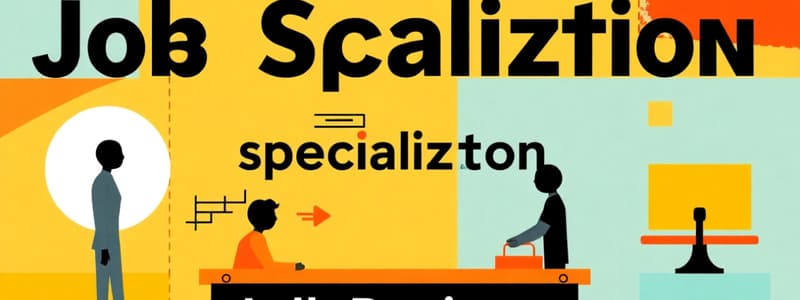Podcast
Questions and Answers
Which of the following is a primary goal of job design?
Which of the following is a primary goal of job design?
- Prioritizing automation over human labor
- Minimizing the need for employee training
- Maximizing employee convenience above all other factors
- Optimizing productivity, employee safety, and quality of work life (correct)
How does job enlargement aim to improve job design?
How does job enlargement aim to improve job design?
- By having workers periodically exchange jobs
- By giving a worker a larger portion of the total task, at the same skill level (correct)
- By giving a worker a smaller, more specialized portion of the total task
- By increasing the level of responsibility for planning and coordination tasks
What is the primary focus of 'job enrichment' as a behavioral approach to job design?
What is the primary focus of 'job enrichment' as a behavioral approach to job design?
- Having workers periodically exchange jobs to broaden their learning experience
- Increasing the level of responsibility for planning and coordination tasks (correct)
- Increasing the variety of skills required for a job
- Giving workers a larger portion of the total task
How do self-directed teams contribute to organizational efficiency?
How do self-directed teams contribute to organizational efficiency?
In the context of ergonomics, what does the 'cognitive' domain primarily address?
In the context of ergonomics, what does the 'cognitive' domain primarily address?
What is the relationship between quality of work life and worker productivity?
What is the relationship between quality of work life and worker productivity?
Which of the following is a key consideration regarding working conditions in job design?
Which of the following is a key consideration regarding working conditions in job design?
What is a potential drawback of long work intervals without breaks?
What is a potential drawback of long work intervals without breaks?
What is the primary difference between a time-based and an output-based compensation system?
What is the primary difference between a time-based and an output-based compensation system?
What is the purpose of incorporating a 'base rate' in a piecework compensation plan?
What is the purpose of incorporating a 'base rate' in a piecework compensation plan?
As companies shift toward lean production, what is the primary reason for recognizing and rewarding workers who can perform a variety of tasks?
As companies shift toward lean production, what is the primary reason for recognizing and rewarding workers who can perform a variety of tasks?
What is the main objective of 'methods analysis' in job design?
What is the main objective of 'methods analysis' in job design?
What is the primary focus of motion study?
What is the primary focus of motion study?
What are 'therbligs' used for in motion study?
What are 'therbligs' used for in motion study?
Why is it important to define the task and inform the worker before conducting a stopwatch time study?
Why is it important to define the task and inform the worker before conducting a stopwatch time study?
In the context of time studies, what does 'OT' represent?
In the context of time studies, what does 'OT' represent?
How are 'standard elemental times' typically used to establish time standards?
How are 'standard elemental times' typically used to establish time standards?
What is the main advantage of using predetermined time standards (like MTM)?
What is the main advantage of using predetermined time standards (like MTM)?
What is the main purpose of work sampling?
What is the main purpose of work sampling?
In work sampling, a hospital administrator wants to estimate the percentage of time that a certain piece of X-ray equipment is not in use. What type of study is this an example of?
In work sampling, a hospital administrator wants to estimate the percentage of time that a certain piece of X-ray equipment is not in use. What type of study is this an example of?
Flashcards
Job design
Job design
Specifying the contents and methods of jobs.
Specialization
Specialization
Concentrating on some aspect of a product or service.
Job Enlargement
Job Enlargement
Giving a worker a larger portion of the total task.
Job Rotation
Job Rotation
Signup and view all the flashcards
Job Enrichment
Job Enrichment
Signup and view all the flashcards
Self-directed teams
Self-directed teams
Signup and view all the flashcards
Ergonomics
Ergonomics
Signup and view all the flashcards
Methods analysis
Methods analysis
Signup and view all the flashcards
Motion study
Motion study
Signup and view all the flashcards
Micromotion study
Micromotion study
Signup and view all the flashcards
Therbligs
Therbligs
Signup and view all the flashcards
Work Sampling
Work Sampling
Signup and view all the flashcards
Work measurement
Work measurement
Signup and view all the flashcards
Standard Time
Standard Time
Signup and view all the flashcards
Stopwatch time study
Stopwatch time study
Signup and view all the flashcards
Standard elemental times
Standard elemental times
Signup and view all the flashcards
Predetermined time standards
Predetermined time standards
Signup and view all the flashcards
Time-based system
Time-based system
Signup and view all the flashcards
Output-based (incentive) system
Output-based (incentive) system
Signup and view all the flashcards
Knowledge-based pay
Knowledge-based pay
Signup and view all the flashcards
Study Notes
Introduction to Work Design
- Work design is crucial because an organization's success depends on human effort.
Job Design
- Job design specifies the content and methods of a job.
- Considerations include what needs to be done, who will do it, how it will be done, and where.
- Objectives include productivity, safety, and quality of work life.
- Two schools of thought exist, an efficiency school and a behavioral school.
- The efficiency school takes a systematic and logical approach.
- The behavioral school emphasizes satisfaction of wants and needs.
- Specialization is a point of contention between the two approaches.
Specialization
- Specialization involves concentrating on a specific aspect of a product or service.
- The primary rationale is to focus efforts and become proficient.
- Highly specialized jobs yield high productivity and lower unit costs.
- Monotony and boredom in lower-level jobs can lead to dissatisfaction, turnover, and absenteeism.
Behavioral Approaches
- Behavioral approaches can make jobs interesting and meaningful.
- Job enlargement gives workers more to do, on the same difficulty level.
- Job rotation involves workers switching jobs.
- Job enrichment involves increasing responsibility for planning and coordination.
- Lean operations utilize job enlargement and enrichment through cross-training.
Motivation
- Motivation impacts the quality and productivity of the work environment.
- Factors include compensation, socialization, self-actualization, status, and a sense of purpose.
- Management is supported in developing motivational frameworks for employees that are positive and goal oriented.
- Trust also influences motivation and productivity.
- An ideal work environment involves trust between workers and managers.
Teams
- Businesses have started rethinking the ways tasks are completed due to efforts to become more productive and competitive.
- Teams and the methods in which workers get paid are being used more and more, especially in lean production systems.
- Teams are now assigned nonroutine assignments with the purpose of developing and delivering solutions to problems.
- Short-term teams collaborate on specific goals such as quality improvement, product design or service design, or solving a problem.
- Self-directed teams are long-term teams increasingly used.
- Self-directed teams are designed to achieve a higher level of teamwork and employee involvement.
- These teams are given the agency to make certain changes in the various tasks in their process.
Ergonomics
- Ergonomics incorporates human factors into the design of the workplace.
- Ergonomics promotes human well-being and system performance.
- Improves productivity by reducing worker discomfort and fatigue.
- Ergonomics involves physical, cognitive, and organizational domains.
- The Gilbreths introduced motion study principles to improve worker efficiency and reduce injury by using ergonomics which also include human-computer interfacing.
Quality of Work Life
- Affects worker well-being, contentment, and productivity.
- Quality of work life includes coworker relationships and good management.
- Working conditions and compensation are also important.
Working Conditions
- Physical factors like temperature, humidity, lighting, noise, and ventilation impact worker performance.
- Governed by government regulations.
Temperature and Humidity
- Work performance tends to be negatively impacted if temperatures or humidity levels are too stressful.
- The stressful levels depend on how intense the work is.
Ventilation
- Noxious smells can be distracting and possibly even a workplace hazard.
- Removing any smoke and grime is necessary to ensure air quality
Illumination
- How well lit the workspace is depends on the type of work being done.
- It is important to have other considerations like the amount of glare and contrast.
- Having good lighting in halls and stairwells can also be a good safety precaution
Noise and Vibrations
- Noise is an unwanted sound that can stem from equipment and people.
- Noise can be distracting and can cause accidents or hearing damage.
- Noise and vibrations can be solved with implementations such as padding, stabilizers, shock absorbers, cushioning, and mounts
Work Time and Work Breaks
- Employees are more happy when work seems flexible, such as work hours or reasonable control
- Long work periods can cause boredom and fatigue.
- Periodic vacation are a means of motivation for workers.
Occupation Health Care
- Positive health outcomes contribute to productivity, less health care costs, and better attitudes of workers.
- Employee fitness and wellness programs are tools that help to keep employees more healthy.
Safety and Ethical Issues
- Worker safety is a basic need within job design.
- There are two sources of risk, accidents and carelessness.
- Ethical Issues affect operations through work methods, safety, accurate record keeping, appraisals, fair pay, and advancement.
Compensation
- A main concern when constructing a work system is employee compensation.
- Suitable plans are beneficial to both the employer and employee.
- There are a variety of pay structures, and they are as follows: time-based, output-based, and knowledge-based.
- The time-based system provides set pay for workers based on their day-to-day work.
- The output-based method is based on the employees production output that would determine their pay.
Management Compensation
- Many organizations are focused on changing their compensation models, with some even considering customer service and satisfaction.
- Depending on the company or division of work, executives pay can even be tied to the performance of the specific division.
Recent Trends
- Emphasis on variable compensation systems.
- Profit sharing and bonuses are viable options.
- The increase of health care costs can also influence what type of compensation package an employee receives.
Methods Analysis
- How a task is done is carefully analyzed.
- Job design first concentrates on the overall operation, then the specific arrangement of motions, materials, and workers.
- New equipment and tools can be one of many reasons why someone would need to analyze and test methods.
Motion Study
- This type of study systematically reviews the human motions used to perform an operation.
- A goal of this study is to remove movements that do not serve the purpose, and discover the most efficient order of movements.
- Frank and Lillian Gilbreth set the foundation for these practices in work
- Effective method can be developed with the motion study practices, which is done with reviewing: principle of motion, analysis of therbligs, micromotion study, and charts.
- There are important guidelines in these different categories to follow when improving motion efficiency in workspace arrangements.
Work measurement
- Concerns determining the time to complete a job.
- Time standards reflect the time it take to complete a task whilst working under typical conditions.
- Common method of work Measurement: Use of stopwatch time study, review historical times, predetermined data, and work sampling.
- All are methods for studying time.
Stopwatch Time Study
- Development of a time standard based on observations of one worker taken over a number of cycles.
- The following main steps are involved in this process: Determine the task, decide how many times to observe cycles, compute target standard time, and measure job and worker's rate of success.
Time standards
- Standards derived from historical time data.
- Standard are found thanks to accumulated data from previous company experiences.
- Analyst must analyze job to see the needed elements.
- It saves time and reduces having to repeatedly go through a complete time study each time.
Predetermined Time Standards
- Data published on what the standards should be that is based of research.
- Analyst must divide job into its basic elements (reach, move, turn, disengage), measure the distances involved (if applicable), rate the difficulty of the element, and then refer to the appropriate table of data to obtain the time for that element.
Work Sampling
- The process of estimating time of a worker based of their various activities done in a work day
- Useful in time studies and unlike time study has more use for ratio delay studies.
- With a sample given of how many tasks a person does or pieces of equipment is being used, managers can better validate and measure time expectations for their employers.
Operation Strategy
- Management should make the design of work systems a key consideration.
- Despite reliance and reliance on technology, businesses still rely on people at their core.
- Workers are valuable and can often provide the best contribution insights due to them doing physical day to day work.
- A spirit of cooperation can often be a good tool in getting the team working together to come to positive resolutions and results.
Studying That Suits You
Use AI to generate personalized quizzes and flashcards to suit your learning preferences.




